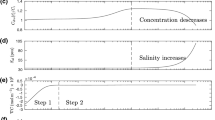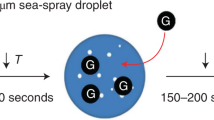Abstract
The role of spume droplets in the air–sea exchange of \(\hbox {CO}_2\) is investigated by applying simultaneous rate equations for the mass of dissolved \(\hbox {CO}_2\), radius, and temperature of a droplet. The life of a droplet can be divided into two phases, except when the air is saturated, and when the air and sea temperatures are the same. In the first phase, the \(\hbox {CO}_2\) fluxes at the droplet surface and at the air–sea interface are in the same direction. In the second phase, the air–droplet \(\hbox {CO}_2\) gradient vanishes, and the droplet loses water and \(\hbox {CO}_2\) as long as there is evaporation. The largest sea–air \(\hbox {CO}_2\) transfer by the droplets is in the case where the sea temperature is greater than the air temperature, and the air–sea \(\hbox {CO}_2\) concentration gradient is towards the air. The net transfer of \(\hbox {CO}_2\) for a droplet depends on its lifetime, which is longer for smaller droplets. The overall role of a droplet spectrum is assessed assuming a sea-spray generation function for radii from 30 to 500 \(\upmu \)m, whose formulation of its dependence on the surface-wave peak period and 10-m wind speed is currently accepted; for situations with an air–sea \(\hbox {CO}_2\) concentration gradient towards the air and a warmer sea than the air, the overall transfer obtained is towards the sea. The effect of the turbulence is analyzed by increasing the droplet lifetime by a factor of 10, which increases the \(\hbox {CO}_2\) flux towards the sea for droplet spectra composed mainly of small droplets (generated by waves with small peak period). However, the mean droplet size is larger for droplets generated by waves with a high peak period, and then the flux is towards the air because many large droplets reach the second phase.






Similar content being viewed by others
References
Andreas EL (1989) Thermal and size evolution of sea spray droplets. U.S. Army Cold Regions Research and Engineering Laboratory, CRREL-Report 89–11
Andreas EL (1992) Sea spray and the turbulent air sea heat fluxes. J Geophys Res 97:11,429–11,441
Andreas EL (1998) A new sea spray generation function for wind speeds up to \(32\,\text{ m }\,\text{ s }^{-1}\). J Phys Oceanogr 28:2175–2184
Andreas EL (2002) A review of the sea spray generation function for the open ocean. In: Perrie W (ed) Atmosphere ocean interaction, vol 1. Wit Press, New York, pp 1–46
Andreas EL (2005a) Approximation formulas for the microphysical properties of saline droplets. Atmos Res 75:323–345
Andreas EL (2005) Handbook of physical constants and functions for use in atmospheric boundary layer studies. ERDC/CRREL Monograph M-05-1, U.S. Army Cold Regions Research and Engineering laboratory, Hanover, NH
Andreas EL (2014) Perspectives on estimating the spray-mediated flux of gases across the air–sea interface. In: 16th conference on atmospheric chemistry. Washington State University, pp 1-11
Andreas EL, Vlahos P, Monahan EC (2016) The potential role of sea spray droplets in facilitating air–sea gas transfer. In: IOP conference series: earth and environmental science, vol 35, no. 1, pp 1–9. http://stacks.iop.org/1755-1315/35/i=1/a=012003
Asher WE, Wanninkhof R (1998) The effect of bubble-mediated gas transfer on purposeful dual gaseous-tracer experiments. J Geophys Res 103:10,555–10,560
Bopp L, Quéré CL (2009) Ocean carbon cycle. In: Quéré CL, Saltman ES (eds) Surface ocean-lower atmosphere processes. American Geophysical Union, Washington, pp 181–195
Feely RA, Alin SR, Carter B, Bednarsěk N, Hales B, Chan F, Hill TM, Gaylord B, Sanford E, Byrne RH, Sabine CL, Greeley D, Juranek L (2016) Chemical and biological impacts of ocean acidification along the west coast of North America. Estuar Coast Shelf Sci 183:260–270
Innocentini V, Gonçalves IA (2010) The impact of spume droplets and wave stress parameterizations on simulated near-surface maritime wind and temperature. J Phys Oceanogr 40(6):1373–1389
Jähne B, Munnich KO, Bosinger R, Dutzi A, Huber W, Libner P (1987) On the parameters influencing air–water gas exchange. J Geophys Res 92:1937–1949
Liss PS (1983) Gas transfer: experiments and geochemical implications. In: Liss PS, Slinn WGN (eds) Air–sea exchange of gases and particles. Springer, Dordrecht, pp 241–298
Liss PS, Merlivat L (1986) Air–sea gas exchange rates: introduction and synthesis. In: Buat-Menard P (ed) The role of air–sea exchange in geochemical cycling. Springer, Dordrecht, pp 113–127
Merlivat L, Memery L (1983) Gas exchange across a air–water interface: experimental results and modeling of bubble contribution to transfer. J Geophys Res 88:707–724
Monahan EC, Staniec A, Vlahos P (2017) Spume drops: their potential role in air–sea gas exchange. J Geophys Res Ocean 112:9500–9517
Pruppacher HR, Klett JD (2010) Microphysics of cloud and precipitation, 2nd edn. Springer Netherlands, Dordrecht
Takahashi T, Sutherland CSC, Sweeney C, Poisson A, Metzl N, Tilbrook B, Bates N, Wanninkhof R, Feely RA, Sabine C, Olafsson J, Nojiri Y (2002) Global sea–air CO\(_2\) flux based on climatological surface ocean \(p\)CO\(_2\), and seasonal biological and temperature effects. Deep Sea Res II 49(II):1601–1622
Wanninkhof R, McGillis WR (1999) A cubic relationship between air–sea CO\(_2\) exchange and wind speed. Geophys Res Lett 26(13):1889–1892
Wanninkhof R, Trin̈anes J (2017) The impact of changing wind speeds on gas transfer and its effect on global air–sea CO\(_2\) fluxes. Glob Biogeochem Cycles 31:961–974
Weiss RF (1974) Carbon dioxide in water and seawater. Mar Chem 2(3):203–215
Woolf DK (1993) Bubbles and air–sea transfer velocity of gases. Atmos Ocean 31:517–540
Woolf DK (2005) Parameterization of gas transfer velocities and sea-state-dependent wave breaking. Tellus 57(B):87–94
Woolf DK, Thorpe SA (1991) Bubbles and the air–sea exchange of gases in near-saturation conditions. J Mar Syst 49:435–466
Zhao D, Toba Y, Suzuki Y, Komori S (2003) Effect of wind-waves on air–sea gas transfer: proposal of an overall CO\(_2\) transfer velocity formula as a function of breaking-wave parameter. Tellus 55B:478–487
Zhao D, Toba Y, Sugioka K, Komori S (2006) New sea spray generation function for spume droplets. J Geophys Res 111:1–11
Acknowledgements
In memory of Dr. Edgar L Andreas for his dedication to understanding the role of droplets at the air–sea interface—without his enlightenment we would never have visited this field. We are grateful for the comments and suggestions from anonymous reviewers. The constructive criticism of Dr. David Richter led to the inclusion of clarifying discussions and improvements in the material presented. We would like to thank Dr. Peter Caplan for his comments and suggestions for improving the English version of this manuscript. This research was supported by Fundação de Amparo à Pesquisa do Estado de São Paulo, FAPESP, Grants 2008/58595-1 and Conselho Nacional de Desenvolvimento Científico e Tecnológico, CNPq, Grants 158985/20 and 429402/2016-3.
Author information
Authors and Affiliations
Corresponding author
Rights and permissions
About this article
Cite this article
Gonçalves, I.A., Innocentini, V. Analytical Quantification of Carbon Dioxide Exchange Mediated by Spume Droplets. Boundary-Layer Meteorol 169, 327–345 (2018). https://doi.org/10.1007/s10546-018-0369-z
Received:
Accepted:
Published:
Issue Date:
DOI: https://doi.org/10.1007/s10546-018-0369-z




